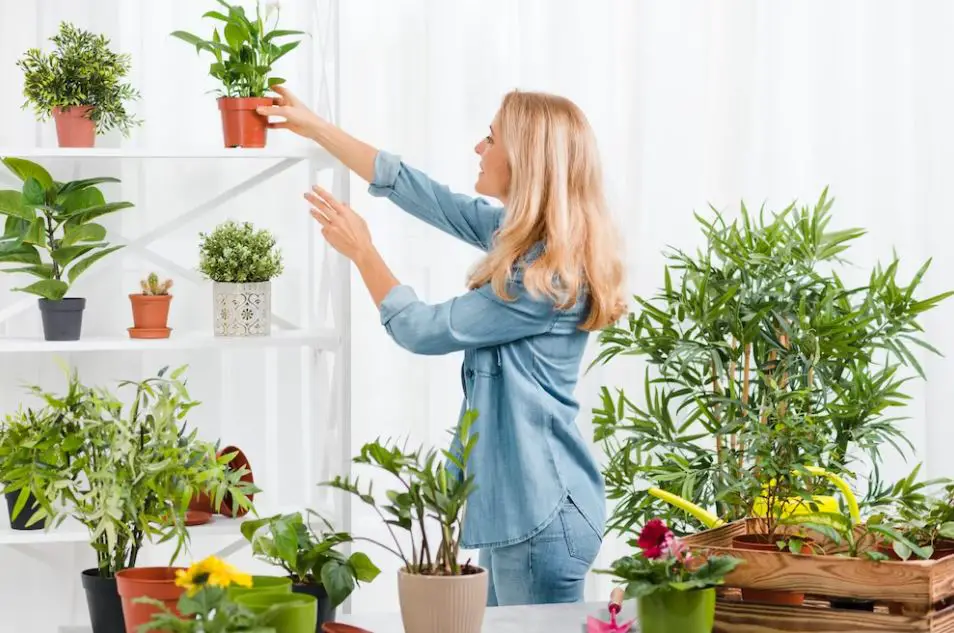Vertical Gardening Indoors: Maximizing Space and Greenery

Have you ever dreamt of having a lush garden but lacked the outdoor space to bring it to life? Well, fret not! With the rising popularity of vertical gardening, you can now transform your indoor spaces into thriving green paradises.
Vertical gardening allows you to utilize wall space or specialized structures to grow plants vertically, making the most of limited space and adding a touch of nature to your surroundings.
In this article, we will delve into the fascinating world of indoor vertical gardening, exploring specific techniques, plant choices, and design considerations that will help you create a stunning and sustainable indoor oasis.
Understanding the Concept of Vertical Gardening
Before we dive into the nitty-gritty details, let’s establish a solid foundation by understanding the concept of vertical gardening.
Unlike traditional horizontal gardening, where plants are grown in rows or beds on the ground, vertical gardening embraces the upward growth of plants.
It involves utilizing walls, trellises, shelves, or other structures to create a vertical growing space. This innovative approach not only maximizes space utilization but also offers aesthetic appeal and functional benefits.
Embracing Space Constraints
One of the primary reasons for opting for vertical gardening indoors is to overcome space constraints. Many urban dwellers find themselves yearning for greenery but lack the luxury of a sprawling garden.
Vertical gardening allows you to make the most of limited space by utilizing vertical surfaces that are often underutilized. From small apartments to office cubicles, vertical gardens can flourish in any indoor setting.
Aesthetic Appeal and Functional Benefits
Beyond the practical aspect, vertical gardens add a unique aesthetic appeal to your indoor environment.
They breathe life into bare walls, creating a visually captivating focal point. In addition, these living walls act as natural air purifiers, enhancing the air quality and promoting a healthier living or working space.
The combination of beauty and functionality makes vertical gardening a compelling choice for those seeking a greener lifestyle.
Designing Your Indoor Vertical Garden
Now that we have grasped the essence of vertical gardening, it’s time to embark on the design journey for your indoor oasis.
Designing an indoor vertical garden involves careful consideration of various elements, including the layout, materials, and plant selection. Let’s explore each of these aspects in detail.
Choosing the Right Location
The first step in designing your indoor vertical garden is selecting the right location. Assess the available space in your home or office and identify a wall or area that receives sufficient natural light.
Plants require adequate sunlight for photosynthesis, so it’s crucial to ensure they have access to the right amount of light for their specific needs.
South-facing walls generally receive the most sunlight, making them an ideal choice for light-loving plants.
Vertical Garden Structures and Supports
Once you’ve identified the location, it’s time to consider the structures and supports for your vertical garden.
There are several options to choose from, ranging from simple trellises and hanging pots to more elaborate modular systems. The choice depends on your aesthetic preferences, available space, and the type of plants you intend to grow.
Remember to select materials that are sturdy, durable, and capable of supporting the weight of plants and their root systems.
Selecting Suitable Plants
Now comes the exciting part: selecting the plants that will thrive in your indoor vertical garden. Not all plants are well-suited for vertical growth, so it’s important to choose species that are known for their adaptability to such environments.
Herbs like basil, thyme, and mint, as well as leafy greens such as lettuce and spinach, are excellent choices for vertical gardens. You can also consider cascading plants like pothos and ivy, which add a cascading charm to your living wall.
Watering and Drainage Considerations
Proper watering and drainage are essential for maintaining a healthy vertical garden. When designing your vertical garden, ensure that it facilitates efficient watering and drainage systems.
Consider incorporating drip irrigation or a misting system that evenly distributes water throughout the plants. Additionally, make sure your chosen structure allows excess water to drain away, preventing waterlogging and potential damage to your plants.
Maintenance and Care Tips for Vertical Gardens
Maintaining an indoor vertical garden requires some effort and attention, but the rewards are undoubtedly worth it. To ensure the longevity and vitality of your green oasis, follow these maintenance and care tips.
Regular Monitoring and Pruning
Keep a close eye on your plants, monitoring their growth and health regularly. Prune any dead or damaged leaves to promote new growth and maintain the overall aesthetic appeal.
Additionally, check for pests and diseases, promptly addressing any issues that may arise.
Watering and Fertilization
Maintain a consistent watering schedule to meet the specific needs of your plants. Avoid overwatering, as it can lead to root rot, while underwatering can cause wilting and stunted growth.
Fertilize your plants periodically to provide them with essential nutrients, but be mindful of the appropriate fertilizer type and dosage for each plant species.
Light Optimization
Ensure that your vertical garden receives adequate natural light. Observe any changes in lighting conditions due to seasonal variations and adjust the placement of your plants accordingly.
You may need to rotate your plants periodically to ensure uniform light exposure and prevent uneven growth.
Vertical gardening indoors opens up a world of possibilities for creating stunning and sustainable green spaces within the confines of your home or office.
By embracing the concept of vertical gardening, carefully designing your space, and providing proper maintenance, you can transform any wall into a vibrant living wall, enriching your surroundings with the beauty and benefits of nature.
So, why wait? Dive into the world of indoor vertical gardening and embark on a delightful journey of greening your indoor spaces!
FAQs (Frequently Asked Questions)
Can I grow flowering plants in my indoor vertical garden?
Absolutely! Many flowering plants, such as orchids, bromeliads, and peace lilies, can thrive in indoor vertical gardens. Ensure they receive adequate light and provide proper care to encourage blooming.
Is it possible to have a vertical garden in a low-light environment?
While most plants require sufficient light for photosynthesis, there are some shade-tolerant species that can thrive in low-light conditions. Examples include snake plants, ZZ plants, and ferns. Make sure to choose plants that are well-suited for low-light environments.
How can I address pest problems in my vertical garden?
Preventing and addressing pest problems in a vertical garden is crucial for maintaining healthy plants. Regularly inspect your plants for signs of pests, such as aphids or spider mites. Consider using natural pest control methods like neem oil or introducing beneficial insects, such as ladybugs, to combat the infestation.
Can I grow vegetables in an indoor vertical garden?
Absolutely! Many vegetables, particularly leafy greens and herbs, can thrive in indoor vertical gardens. Lettuce, kale, spinach, and herbs like basil and mint are popular choices for vertical vegetable gardens. Just ensure they receive sufficient light and meet their specific growth requirements.
How can I ensure proper ventilation in my indoor vertical garden?
Proper ventilation is essential for the health and well-being of your plants. To enhance the airflow in your indoor vertical garden, you can strategically place fans or ensure that there is natural air circulation in the room.
Open windows or use exhaust fans to promote fresh air exchange. This helps prevent the buildup of excess humidity and reduces the risk of fungal diseases.
With these ventilation measures in place, your plants will thrive in a well-ventilated environment, ensuring optimal growth and overall health.
Vertical gardening indoors offers a world of possibilities for those who want to embrace the beauty of nature in limited spaces.
By understanding the concept, designing with intention, and providing proper care, you can create a flourishing vertical garden that not only enhances the aesthetic appeal of your indoor environment but also brings a sense of tranquility and well-being.
So, unleash your creativity, choose the right plants, design an efficient vertical structure, and embark on your journey to transform your indoor space into a green haven. Happy gardening!
Also READ!
Homemade Fertilizer For Plants Growing In Water. READ: homeimprove360.com/homemade-fertilizers/
